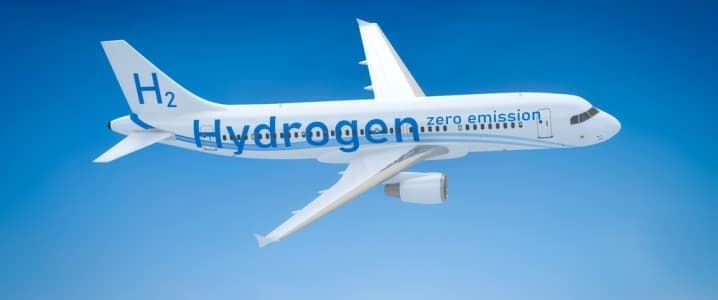
The International Council on Clean Transport released a white paper on Performance Analysis of Evolutionary Hydrogen-Powered Aircraft earlier this year, assessing the potential use of sustainable aviation fuels (SAFs), particularly liquid hydrogen (LH2), to decarbonize the aviation industry. The paper suggested that the introduction of LH2 aircraft into the global fleet, starting in 2035, could contribute to aviation’s 2050 climate goals. However, hydrogen-fuelled planes would likely have a shorter range than fossil fuel aircraft and a higher energy requirement per revenue-passenger-kilometer, with the potential to carry approximately 165 passengers up to 3,400 km.
Several ambitious hydrogen plane projects are already taking off around the world, with numerous major aviation firms announcing investments in green-powered planes. In 2020, Airbus announced three hydrogen fuel concept planes, under the project ZEROe. The fleet includes a jet airliner with a liquid hydrogen tank aimed at carrying 200 passengers over 3,500km, a similar ‘blended-wing body’ design with a different hydrogen storage and propulsion system, and a propeller plane with hydrogen combustion in modified gas-turbine engines to carry 100 passengers over shorter distances. Delta Air Lines has already announced a partnership with Airbus to develop its hydrogen technologies.
Budget airlines are also demonstrating their interest in decarbonized flying, with European aviation firm Wizz Air announcing its preliminary agreement with Airbus to explore the potential for hydrogen-fuelled aircraft last month. The companies will evaluate how hydrogen fuel planes would affect scheduling, ground bases, and airport operations. In addition, they will assess the potential range, refueling time, and regulatory requirements for the planes to see whether an LH2 fleet is achievable.
Chief People and ESG Officer at Wizz Air Johan Eidhagen stated, “We believe that growth and sustainability are not mutually exclusive, with leading-edge new technology paving the way to more sustainable air travel.” Adding, “this ... agreement with Airbus will advance sustainable aviation across the globe through development of ultra-efficient operations and business models of the future.”
While Airbus thinks it will be at least 15 years until commercial hydrogen aircraft are ready for flight, smaller concept planes are already taking off. In the U.K., ZeroAvia is planning to test its first hydrogen fuel cell, a 19-seat plane in mid-July. It is expected to be followed by a second test flight in California later in the summer. It contains two dual-engines capable of converting hydrogen into electricity to drive propellers, as well as batteries on one side and a conventional jet engine on the other. It will be the first double-digit passenger-size hydrogen flight to be tested worldwide.
ZeroAvia has raised $115 million from several private companies, including United Airlines, Alaska Airlines, British Airways, Amazon, and Shell, with the hope of launching a small commercial hydrogen plane by late 2024. CEO and founder of ZeroAvia Val Miftakhov explained, “Airlines are really interested in this because they’re under more and more pressure from governments but also from the flying public.” He added, ?“people started realizing that they have very significant carbon footprints from aviation.”
Meanwhile, in Australia, the Skytrans airline believes it will have its first hydrogen-fuelled flights up and running by 2026, aiming to become a completely net-zero airline by 2050. Skytrans plans to partner with the aircraft firm Stralis to retrofit a 19-seat Beech B1900D-HE, with the potential of transporting 15 passengers over 800 km at costs near that of a traditional flight.
Despite significant strides being seen in hydrogen aviation, some point out the considerable challenges needed to be overcome to achieve commercial LH2 flight. Managing director at advisory firm Aviation Projects Keith Tonkin explained, “Broadly speaking, we’re talking about brand new technologies and trying to create a new system of energy provision around the world for hydrogen. There’s a whole load of supply chain tasks to put in place for getting the hydrogen out to the places where the aircraft are.” Adding, “Also making [green] hydrogen needs lots of power, so there’s also work to do in renewable energy.”
While great progress has been made in hydrogen aviation technology in recent years, thanks to greater interest and investment from the global aviation industry, there is still a long way to go until large commercial passenger services become available. The green hydrogen industry must be developed substantially to develop the hydrogen market and the global supply chain if airlines hope to run hydrogen-fuelled services within the next decade or two.